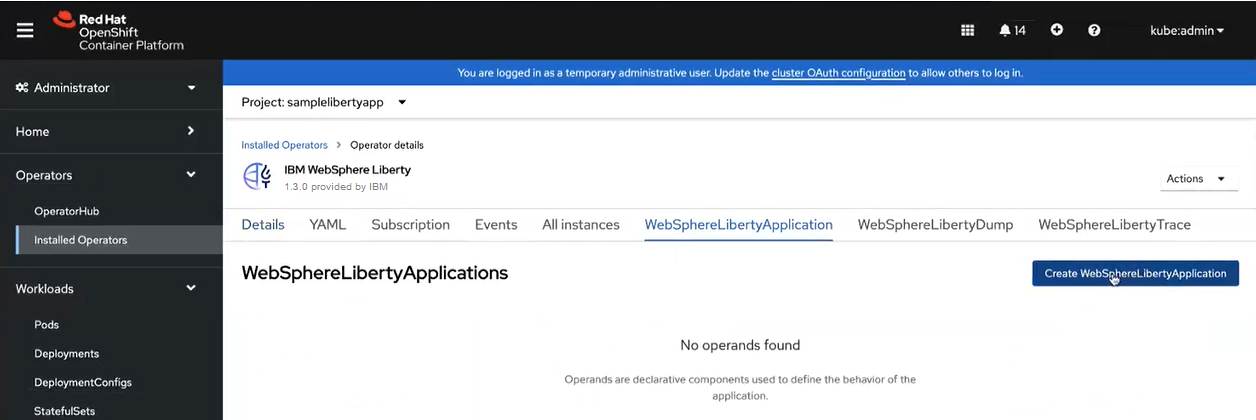Deploy the WebSphere Liberty operator sample application
After the operator installation, an application administrator can deploy the sample application image for WebSphereLibertyApplication to a Kubernetes environment. Deploy the application image with the Red Hat OpenShift console or with kubectl or oc commands.
The WebSphere Liberty operator must be installed on all namespaces or in the namespace where we want to deploy the sample application.
The deployed sample application shows the system properties for the application in a browser.

Deploy the sample application with the Red Hat OpenShift console
- In the Red Hat OpenShift console navigation menu, click Operators > Installed Operators.
- On the Installed Operators page, create a project for the sample.
- Select the project for the operator installation from the Project list and ensure that IBM WebSphere Liberty is in the list of installed operator names. The operator must be installed on the cluster or in the project in which we want to install the sample.
- Expand the Project list and click Create Project.
- In the Create Project dialog, specify a Name value such as samplelibertyapp and click Create.
- With the samplelibertyapp project selected in the Project list, click the IBM WebSphere Liberty operator.

- Select the project for the operator installation from the Project list and ensure that IBM WebSphere Liberty is in the list of installed operator names. The operator must be installed on the cluster or in the project in which we want to install the sample.
- On the Operator details page, create an instance of the WebSphereLibertyApplication sample application.
- Click the WebSphereLibertyApplication tab.
- Click Create WebSphereLibertyApplication.

- On the Create WebSphereLibertyApplication page, configure the application in the Form view or in the YAML view.
We can use the Form view to change operator parameter values and then use the YAML view to see the configured application custom resource.
To configure the application in the Form view...
- Expand License and select accept.
- Set the Expose value to true.
- Click Create.
To configure the application in the YAML view, ensure that the custom resource has the following changes.
- The .spec.license.accept parameter must be set to true to accept the license.
- The .spec.expose parameter must be set it to true to expose the application with a route so we can run and view the sample application.
The .spec.applicationImage parameter value for the sample application does not require changes. It already specifies the path to the sample application provided with the WebSphere Liberty operator.
After changes, the YAML resembles the following custom resource definition.
apiVersion: liberty.websphere.ibm.com/v1 kind: WebSphereLibertyApplication metadata: name: websphereliberty-app-sample namespace: samplelibertyapp spec: license: accept: true edition: IBM WebSphere Application Server productEntitlementSource: Standalone applicationImage: >- icr.io/appcafe/open-liberty/samples/getting-started@sha256:e22dd56a05e44618a10d275d3ff07a38eb364c0f04f86ffe9618d83dd5467860 manageTLS: true expose: true - In the Red Hat OpenShift console navigation menu, click Workloads > Pods to ensure that the pod on which we installed the sample application is running.
- In the Red Hat OpenShift console navigation menu, click Networking > Routes to see the route of the sample application. Click the Location link to run the sample application and view it in a browser.
Deploy the sample application with the CLI
- Configure a custom resource (CR) YAML file for the WebSphereLibertyApplication to deploy the sample application.
Ensure that the CR has the following settings.
- The .spec.license.accept value must specify true.
- If the product edition is other than the default, IBM WebSphere Application Server (base), the .spec.license.edition value must specify our product edition.
Other available values are IBM WebSphere Application Server Liberty Core and IBM WebSphere Application Server Network Deployment.
- If the product for which we have a license is other than the default, Standalone, which includes WebSphere Application Server products such as Liberty, the .spec.license.productEntitlementSource value must specify another product. Other available options are IBM Cloud Pak for Applications, IBM WebSphere Application Server Family Edition, and IBM WebSphere Hybrid Edition.
- The .spec.applicationImage parameter value must specify the path to the sample application provided with the WebSphere Liberty operator.
- The .spec.expose parameter must be set it to true to expose the application with a route so we can run and view the sample application.
The following CR sets .spec.license.accept to true for the IBM WebSphere Application Server stand-alone product, specifies a path to the application image with .spec.applicationImage, and sets .spec.expose to true.
apiVersion: liberty.websphere.ibm.com/v1 kind: WebSphereLibertyApplication metadata: name: websphereliberty-app-sample namespace: samplelibertyapp spec: license: accept: true edition: IBM WebSphere Application Server productEntitlementSource: Standalone applicationImage: >- icr.io/appcafe/open-liberty/samples/getting-started@sha256:e22dd56a05e44618a10d275d3ff07a38eb364c0f04f86ffe9618d83dd5467860 manageTLS: true expose: trueBy default, .spec.manageTLS is set to true and does not need to be specified in the CR. If we deploy the CR to a Kubernetes cluster, we must have certificate manager installed on the Kubernetes cluster. If we deploy the CR to an Red Hat OpenShift cluster, then the certificate manager installation is not required.
- The .spec.license.accept value must specify true.
- Deploy your CR to a running cluster in a Kubernetes environment.
To use the CLI to apply your CR, run a kubectl apply or oc apply command.
To run kubectl commands, we need the Kubernetes command line tool or the Red Hat OpenShift command-line interface (CLI). To run oc commands, we need the Red Hat OpenShift CLI.
In the following apply commands, replace CR-YAML with your CR file name.
- Run the following kubectl apply
command.
- kubectl apply -f CR-YAML
- Run the following oc apply command.
- oc apply -f CR-YAML
- Run the following kubectl apply
command.
- Check that sample application pods are running.
- kubectl get pods -n samplelibertyapp
- oc get pods -n samplelibertyapp
- Get the route of the application.
- kubectl get routes -n samplelibertyapp
- oc get routes -n samplelibertyapp
The output has a HOST/PORT value that provides a URL to the sample application.
NAME HOST/PORT PATH SERVICES PORT TERMINATION WILDCARD websphereliberty-app-sample websphereliberty-app-sample-samplelibertyapp.apps.ibm.com websphereliberty-app-sample 9443-tcp reencrypt None
- Copy the URL (HOST/PORT) from the route and view the deployed sample application in a browser.